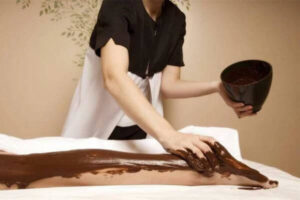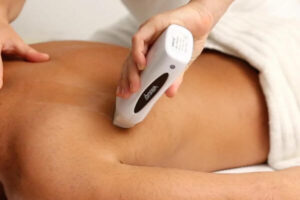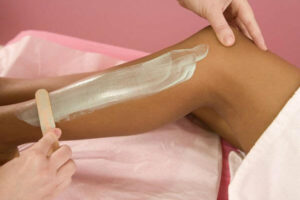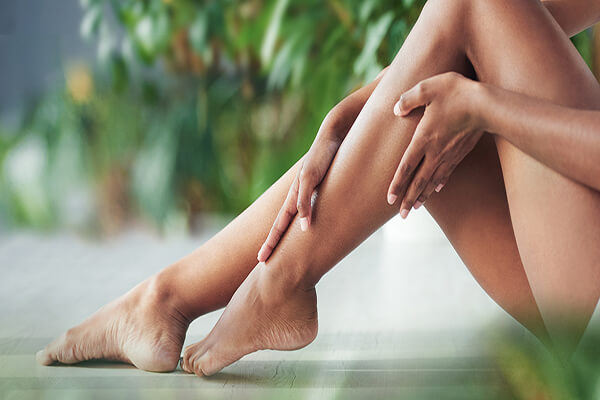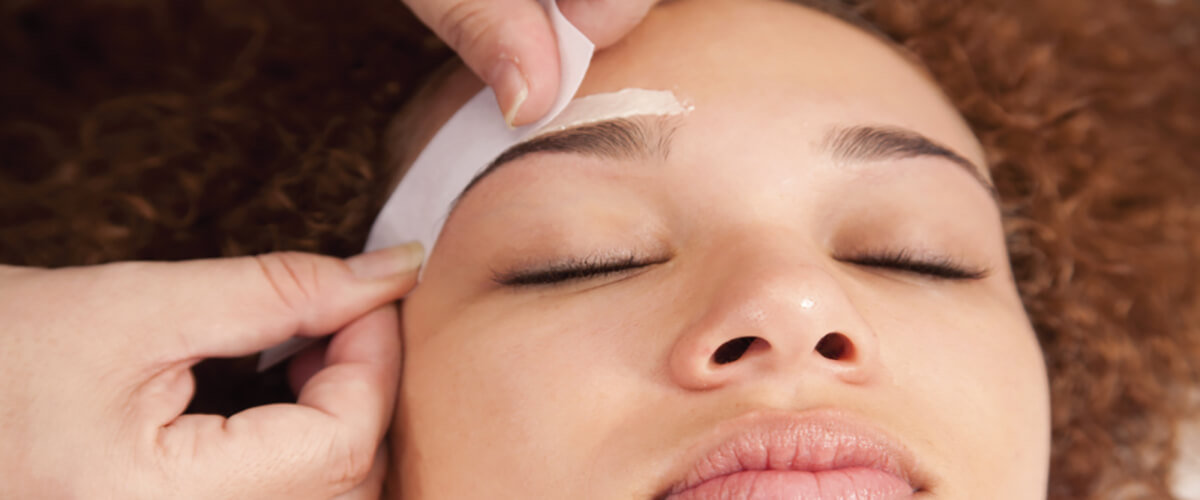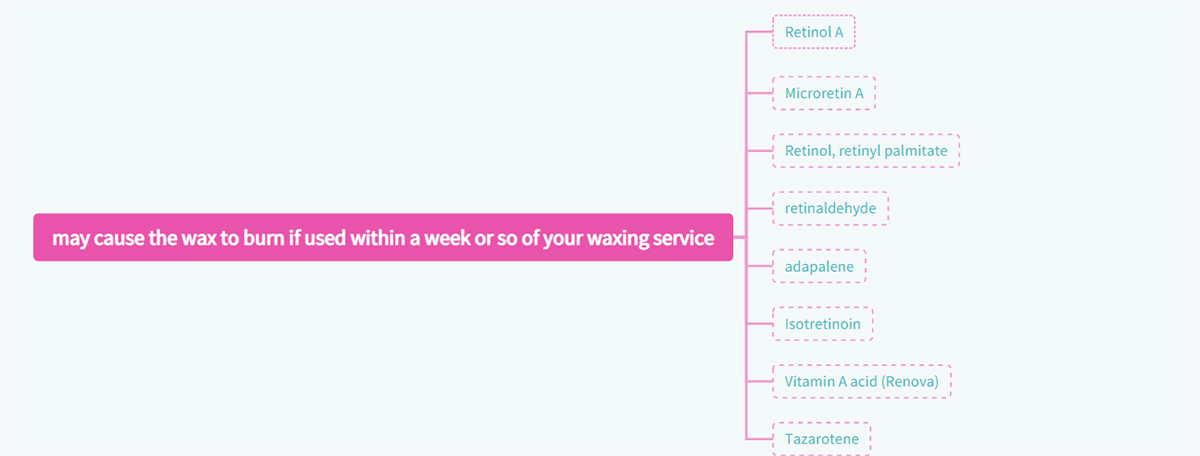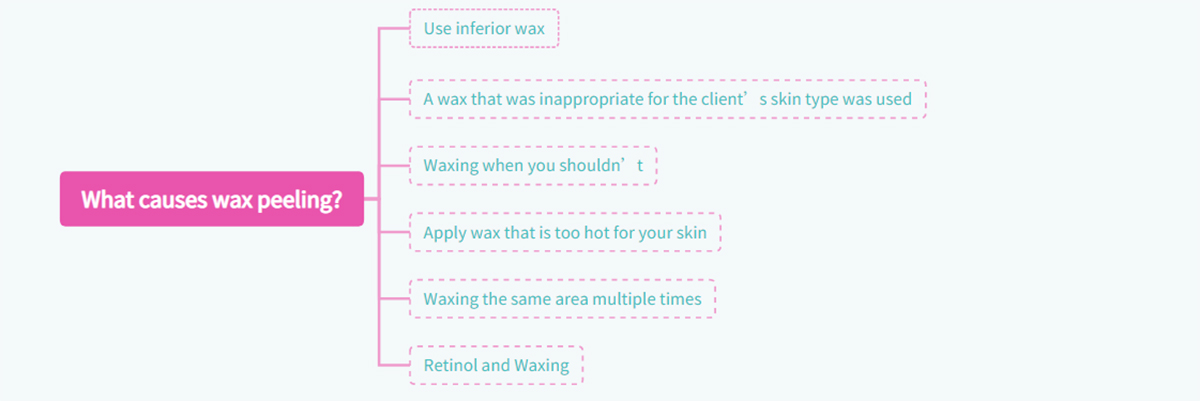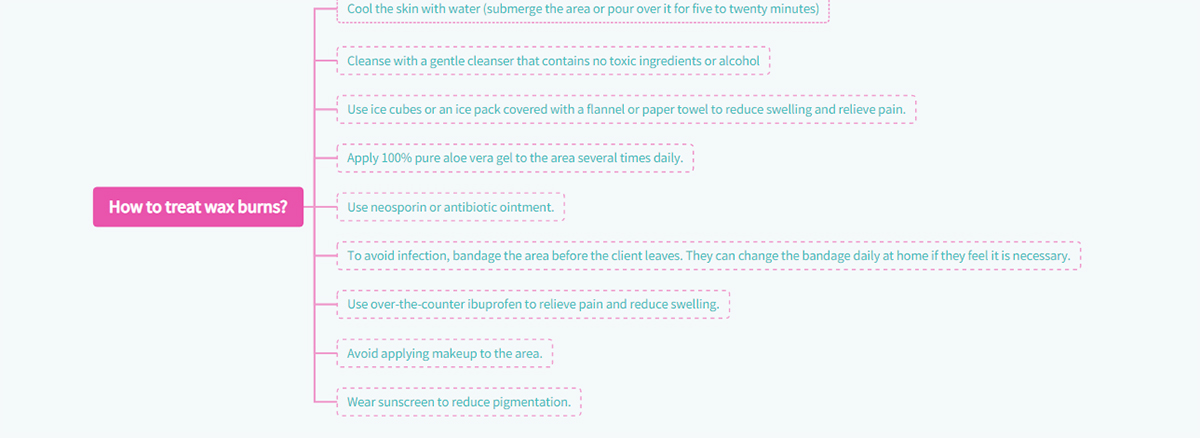When providing waxing services, ensuring the safety and satisfaction of your clients is paramount. However, even the most experienced estheticians can encounter challenges such as skin lifting or wax burns, which can lead to discomfort, scarring, or even loss of client trust. This comprehensive guide will walk you through the best practices for using quality wax, understanding the impact of waxing on sweat and preventing and treating common waxing-related injuries. By following these tips, you can enhance your clients’ experience and protect your reputation as a professional.
1. What is waxing and wrinkle lifting?
Skin lifting from waxing, also known as wax burn, is a wound caused by the wax grabbing more of your client’s skin than you intended. Typically, wax burns only go deep to the surface of the skin, but may leave the client susceptible to bacteria, scarring, and pigmentation. Wax burns on the legs or back are less common, but more common during an eyebrow or Brazilian waxing procedure.
A wax burn on your skin, an eyebrow wax burn, or a Brazilian wax burn can all look like a severe scrape or a minor scrape on your knee. Sometimes, you and your client won’t even notice it’s there until it starts to scab over within a day or two. Depending on the client and the size of the burn, minor abrasions will not affect them, but for more severe cases, it is important to have a good aftercare routine to heal the wound properly.
2. What are the benefits of using quality wax?
Are you a beautician or a spa owner? If so, then of course you want your clients to be satisfied when they have a hair removal session at your spa or salon. As you probably already know, choosing a high-quality wax is essential to provide your clients with a comfortable waxing experience and to protect their skin, as this is the only way to guarantee successful hair removal.
This will keep customers happy and keep them wanting to go back every time they need wax. In addition to choosing the right wax, it’s also important to choose quality pre- and post-epilation products. What Makes a Quality Wax? How and from what it’s made. The main component of depilatory wax is resin. However, there are different types of resins. Therefore, the type of resin used and how it is processed determines the quality of the wax.
Some resins are natural and some are synthetic. Resins produced by trees as a response to damage act like a bandage, protecting the trunk from insects and pathogens while the bark heals. In addition to being modified and purified, these resins are also used to make waxes suitable for all skin types.
Poor-quality resins are often not purified and can cause skin irritation, redness, itching, and dermatitis. In addition to resins, there are other ingredients that can be used to produce waxes. Some waxes contain chocolate, which has long been known to be a great moisturizer and toner. Others contain milk extract, which acts as an antioxidant, while those with fruit oil contain vitamins and minerals to prevent skin irritation.
1) They help prevent inflammation and reduce the risk of infection
A high-quality wax not only removes hair easily but also protects the skin. This is because after waxing, the top layer of the skin is also removed, which can leave it temporarily irritated and susceptible to environmental factors that can cause infection. High-quality waxes often contain anti-inflammatory properties and antioxidants. Chamomile is a natural antioxidant found in some waxes. Due to its antiseptic, antibacterial, and antiallergic properties, this plant has been used for centuries for therapeutic purposes. When using a wax containing chamomile, its natural anti-inflammatory compounds help reduce irritation and prevent infection.
2) They soothe the skin
High-quality waxes contain ingredients that help make skin soft and smooth after a waxing procedure. One of the functions of the skin is to sense pain. Therefore, it is important to choose a wax with emollient and moisturizing properties to soothe the waxed area. Based on these facts, we recommend that you check the ingredients before purchasing a wax. For example, look for waxes that contain chamomile, and you can rest assured that your clients will be served top-notch by using a product with purifying and anti-inflammatory properties.
We offer a range of products containing the above ingredients, such as our Azulene Wax, which contains chamomile extract to calm and soothe delicate skin. We also have our Choco therapy range, enriched with cocoa and sweet almond oils, allowing your clients to enjoy the benefits of chocolate. If you’re looking to complement your salon or spa with premium waxes, we’ve got it. If you would like more information or fill out the form on this page, please call toll-free.
3. What is the effect of waxing on sweat?
You’ve probably heard of the many benefits body wax has to offer in the skincare department. Thanks to all the natural properties in its formula, Professional Hard Wax is harmless to most skin types and actively helps sensitive areas of the body. Sweat is one of the most troublesome issues these days and often gets in the way of an effective skincare routine. If the area is not properly cleaned before waxing, sweat and perspiration can cause serious skin damage.
Some people sweat more than others, and their specific sleep habits can affect how much they sweat. Either way, it’s only natural to ask ourselves, does waxing help sweat? Our team is here to clear up any doubts you may have. In some cases, it can be difficult to keep the skin clear. Everyone sweats regularly as the body adapts to the heat, but excessive sweating is another issue.
A person may be naturally prone to sweating, they may live in a warm location, or their daily routine involves some level of physical exertion. Excessive sweating can have a host of nasty side effects, starting with unpleasant body odor, general discomfort, and cosmetic blemishes for many, not to mention personal hygiene offenses and increased risk of infection. Dealing with it can be frustrating, to say the least.
1) What to do if you sweat too much?
While sweating is a natural consequence of normal bodily functions, reducing your body’s water levels is a good choice in every way. Not only will it help you maintain proper hygiene standards, but it will also prevent premature discoloration of your clothes. There are medical alternatives to treat severe cases, including antiperspirants and/or medications prescribed through ongoing treatment. Options include Botox and iontophoresis.
Surgical removal of sweat glands is also available in patients with excessive sweating but is usually a last resort. You can reduce sweat on your body without resorting to such extreme/expensive methods by following these tips:
- Introduce antimicrobial solutions in your personal hygiene: Soaps, deodorants, and lotions with antimicrobial properties can protect your skin in everyday life while eliminating body odor. When you limit the way bacteria can grow and colonize your skin, you also reduce the worst effects of sweat. Regular use of hygiene products can also help keep your body temperature fresh.
- Use a regular antiperspirant: Always use a deodorant or natural antiperspirant after washing your skin. You should always do this when you plan to go out. Depending on your routine, you can also use antiperspirant before bed or at the beginning of the day.
- Watch what you eat: Hot food can increase your body temperature just like an external heat source. Pay special attention to spicy foods; they heat up the body quickly after eating, so their intake should be kept to a minimum.
- Let your body breathe through your clothes: If you sweat easily, cotton and silk are the best choices for your wardrobe. Tight clothing can be attractive in some situations but try to dress in a balanced way that lets fresh air into your skin. You can also take a change of clothes to certain places, depending on the duration of the activity and how physically demanding you are.
- Body Hair Removal: Hair on the skin absorbs sweat, traps it, and amplifies body odors while regulating temperature. That’s why the armpits, inner thighs, and intimate areas are such difficult areas to deal with when there’s no way to prevent excess body hair growth. Aside from being the most hygienic method overall, regular hair removal solutions avoid these problems. It also hinders the growth of bacteria, reducing body odor in the process.
Now that we know that hairless skin sweats less, we need to ask: Does waxing help sweat? While many products and methods can achieve body hair removal goals, professional waxes offer a myriad of long-term benefits, making them the perfect addition to your skincare routine.
2) How does waxing help sweat?
Of all the hair removal methods available, few leave such long-lasting results. After one wax session, the skin will stay smooth and hair-free for 3 to 6 weeks, which is great if you want to reduce sweating from your body. On the one hand, it makes it easier to keep your skin clear and helps you withstand the heat more comfortably, but there are other advantages as well.
After waxing, new hair grows finer and is easier to pull out during subsequent waxing sessions, as the wax gradually destroys the follicles until the hair stops growing forever. By eliminating the problems associated with growing body hair, regulating how much your body sweats will be made simpler.
3) The importance of getting a professional wax
Professional wax products offer a wider range of benefits, and advice from a certified beautician will come in handy to help you deal with future body sweat. Some places are particularly prone to sweating. For example, the armpits get a lot of friction and have much more hair than the rest of the body. Most hair removal solutions are not effective in many of these areas due to their sensitivity.
Hard body waxes are an ideal alternative to treating sensitive areas of the body, as they leave the skin silky and fresh enough to withstand temperature changes without causing excessive sweating and unpleasant odors. Antioxidant face creams are also a key element of a professional waxing service, so skin remains protected from bacteria and infections when it is at its most vulnerable, ie after a wax.
If you want to reap all the benefits of regular waxing, you can rely on us to provide the best products and accessories. Our formula keeps the skin of all types smooth and hair-free for weeks on end, reducing the chance of the build-up of sweat, product residue, and other unhygienic elements. To start shopping for the best hair removal products for your salon, call toll-free or fill out the contact form on our website. We will provide the best quality and help you exceed customer expectations. Don’t forget to subscribe to our newsletter to get the latest news and tips straight to your inbox.
4. Retinol and waxing
“Retinol” contains vitamin A derivatives (a type of retinoid). Retinol products, while used as an ingredient in many skin care products, may leave your skin vulnerable to damage from external sources like waxing.
Some customers may not realize they are taking a powerful derivative of vitamin A. When asked if they are using retinol products, they may unknowingly answer “no” on the intake form, thereby increasing the risk of damage from retinol use and waxing. Make sure you fully educate your clients on retinol and make sure they double-check their skincare ingredients to avoid mishaps.
Here is a list of retinoids that may cause the wax to burn if used within a week or so of your waxing service:
- Retinol A
- Microretin A
- Retinol, retinyl palmitate
- retinaldehyde
- adapalene
- Isotretinoin
- Vitamin A acid (Renova)
- Tazarotene
Instruct your clients to avoid tretinoin five to seven days before their appointment or have them reschedule. Always ask your client if they are using retinoids before providing services unless you know for a fact that they are not, then ask anyway to avoid mixing retinol and waxing.
5. What causes wax peeling?
Here are some factors that can cause facial or body wax burns:
- Use inferior wax
- A wax that was inappropriate for the client’s skin type was used
- Waxing when you shouldn’t
- Apply wax that is too hot for your skin
- Waxing the same area multiple times
- Retinol and Waxing
1) Will waxing tear your skin?
As we mentioned, waxing-induced skin lifting occurs when the wax grabs both hair and skin when applied, resulting in the lifting/burning of both hair and skin.
This can be considered a form of “tearing” or “tearing,” but is often referred to as “lifting” because the skin is simply burned rather than actually torn. Don’t worry – even if it looks like your eyebrow wax has been ripped off, it’s not! It’s just a burn that can be soothed and healed quickly.
2) Wax burn caused by inferior wax
When you use low-quality wax, you increase the likelihood of skin damage due to questionable melting points, uneven heating, breakage, or the need to wipe an area multiple times because the wax is ineffective. However, there is an easy solution and that is to use Auperwel Premium High Quality Wax!
3) Using wax that is inappropriate for the client’s skin type
To keep your skin safe, remember to use the correct type of wax for your client’s skin. Understanding skin type and sensitivity is crucial for safe, successful hair removal waxing.
4) Best wax for sensitive skin
To prevent your skin from tearing due to waxing, it is important to use only the highest quality wax. Especially for sensitive skin, use only waxes formulated specifically for these uses.
Star Soft Wax: Designed for those with irritated, dry, or aging skin, this wax is ideal for soothing inflammation, irritation, and redness while providing clients with smooth, long-lasting results.
Coral Hard Wax Beads: Another powerful product for ultra-sensitive skin, our Coral Membrane Hard Wax detoxifies the skin and speeds recovery while leaving it hair-free and glowing.
Creamy Pink Soft Wax: Ideal for use on delicate, hard-to-reach areas, this wax is gentle on the skin while still grabbing the finest hairs.
Non-Woven Soft Wax Strips: Pair these durable strips with soft wax for stunning and effective results every time.
5) Applying too hot wax to your skin
Whether you use hard or soft wax, if the wax is too hot, it will fuse with the top layers of your skin and pull those layers away with the hair. To achieve the correct temperature, follow the instructions of a professional wax and wax warmer and keep the wax at a thick, honey-like consistency. Always test your wax before using it to take hot wax out of the skin-lifting equation.
6) Wax the same area multiple times
Generally speaking, if you use the right wax correctly and at the right temperature, you can apply wax multiple times to the same area on areas with thicker skin, such as your legs or back. Always use your best judgment! Generally, it is not wise to do two treatments on sensitive skin, facial areas, or Brazilian areas.
Do not re-apply the skin with soft wax, especially the facial area. You can use the same non-woven wax strip and rub the removed wax over your skin several times if you feel your skin is in good condition, but as always, use your best judgment.
If you find missed hairs, insert them with tweezers or a smaller waxing spatula to avoid overlapping onto previously waxed skin (if your skin is sensitive).
6. How to treat wax burns?
To treat wax burns, run the affected area under cold water for 20 minutes, then apply cold pressure to it to relieve pain or inflammation. Do not place ice cubes or ice packs in the area. Follow with an antibacterial soothing ointment such as Neosporin or Bacitracin and continue treating the area as needed.
How to heal torn skin caused by waxing
Follow these tips as soon as possible and have the client continue with these steps for ongoing wax burn treatment.
- Cool the skin with water (submerge the area or pour over it for five to twenty minutes)
- Cleanse with a gentle cleanser that contains no toxic ingredients or alcohol
- Use ice cubes or an ice pack covered with a flannel or paper towel to reduce swelling and relieve pain.
- Apply 100% pure aloe vera gel to the area several times daily.
- Use neosporin or antibiotic ointment.
- To avoid infection, bandage the area before the client leaves. They can change the bandage daily at home if they feel it is necessary.
- Use over-the-counter ibuprofen to relieve pain and reduce swelling.
- Avoid applying makeup to the area.
- Wear sunscreen to reduce pigmentation.
If you’re wondering how long it will take for waxed torn skin to heal, it’s usually about 1-2 weeks. That said, everyone’s skin is different, and some people’s skin heals faster or slower than others.
7. Wax salon insurance policy
Since you never know what might happen, make sure you have a good salon policy that includes client exemptions. First, check your state’s laws to determine what type of customer exemption you can offer your customers when making a reservation. Work with your representative to develop a salon exemption form that best represents your business. A client waiver is a form that does not hold you liable for certain damages that may occur while visiting the salon.
A good beauty business insurance plan should protect you from negligence claims, emotional trauma, lost wages, or a breach of sensitive customer data. General liability insurance should protect you against property damage claims, personal injury, related medical bills, and defamation. In addition to taking precautions and treatments to ensure your client’s safety and protection in the case of wax burns, take any necessary steps to mitigate any ill intentions in a way that feels comfortable to you.
This could include not charging for an appointment or sending a follow-up card, for example. Whatever you believe is the reason for a skin lift, please use your best judgment and proceed in a manner that is consistent with your salon policies and client exemptions.
8. Waxing FAQs
The following are some common questions and their solutions.
1) Is it safe to wax all areas?
Hair removal is generally safe for most skin types and areas but is not recommended for patients with diabetes, varicose veins, rosacea, phlebitis, circulation problems, or skin conditions that cause thinning or sensitive skin. Waxing is not advisable for people with medical conditions such as lupus, or HIV, or those undergoing cancer treatment.
Pregnant women and people taking birth control pills, blood thinners, or hormone replacement drugs should be extra careful when removing hair. Don’t wax people with tretinoin or other prescription medications or strong acne treatments like Differin. If you see inflamed, irritated, or sunburned skin, avoid it. Do not wax body piercings, rashes, moles, or warts. You should also avoid hair removal for anyone who has had Botox, retinol, sunburn, or recent hair removal.
Make sure your clients know all of this information before using your spa bed, put it all on your website, and have them sign a waiver saying they understand the terms before booking.
2) What to do if your client gets wax burn
No matter how it happened, when you notice damage, get it treated immediately. Use the word “we” as a warning to your client until the cause of the burn is completely determined:
If your client doesn’t know what wax burn is, educate them so they know how long it lasts and how to get rid of it. Typically, a wax burn will heal within four or five days, but it may take about a week or two to completely disappear. This does not include potential scarring or pigmentation.
Removing wax burns takes time. It’s okay to downplay it when you’re in a limiting panic moment, but it’s important to emphasize home care education on how to heal torn skin from waxing.
9. Conclusion
In conclusion, providing top-quality waxing services requires a thorough understanding of both the products used and the potential challenges that can arise during the process. From selecting the best wax to managing common issues like skin lifting and wax burns, it’s essential to be well-prepared to ensure the safety and satisfaction of your clients. By following the guidelines outlined in this article, you can enhance the overall waxing experience, maintain client trust, and protect your business from potential risks. Remember, your commitment to quality and client care will set you apart as a trusted professional in the beauty industry.
How useful was this post?
Click on a star to rate it!
Average rating 0 / 5. Vote count: 0
No votes so far! Be the first to rate this post.
